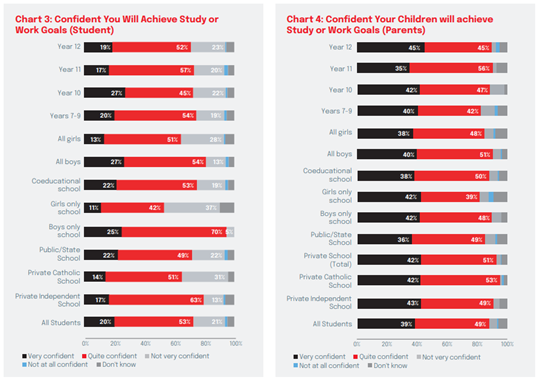
For senior students on the cusp of entering adulthood, feeling prepared for the world outside the school gates and optimistic about their future is paramount. It's these feelings of readiness and hope that lay the foundation for a successful transition into the next chapter of their lives.
As Australia's education landscape shifts and adapts, understanding the hopes, fears, and ambitions of our upcoming generation is more crucial than ever.
NAB recently released Part 3 of its ‘Education Insights Special Report’ series, which taps into life after school, student hopes and goals, family expectations and potential barriers.
Part 1 of the Series explored the wellbeing of young Australians through the eyes of both high school students and parents. Part 2 delved into student experiences and self-assessment while at school. Part 3 concludes this series by looking at life beyond school, including student career goals, potential barriers, and optimism about the future.
What the report found
The latest research from NAB, which surveyed more than 400 students (across years 7-12) and 500 parents from around the country, reveals high confidence from young people in their tertiary plans, with nearly 8 in 10 (78%) students planning to go to university after they finish high school, and 1 in 2 (50%) getting a job.
Significantly more students at girls-only schools plan to go to university (89%), get a job (56%), take a gap year and travel overseas (26%), or do something else (10%). Conversely, more students at boys-only schools plan to get an apprenticeship (20%) or work in their business (15%).
The highest number of students "very" confident of achieving their study or work goals was highest in public or state schools (22%), at boys-only schools (25%), boys in general (27%), and in year 10 (27%). It was lowest in private Catholic schools (14%), girls-only schools (11%), girls in general (13%), and year 11 students (17%).
However, the combined number of students that were "very" or "quite" confident was somewhat higher in private independent schools (80%), particularly compared to private Catholic schools (65%). It was also much higher in boys-only schools (95%) compared to girls-only schools (53%), and for boys in general (81%) than girls (65%). There was little difference by year level, ranging from 71% in year 12 to 75% in years 7-9.

Students feel optimistic about post-school life
Peter Atanasovski, NAB Business Bank Executive, said one thing he found particularly encouraging about the report is that overall, Australian students are feeling optimistic about life after school.
“Many expect to undertake further education, most are confident they can achieve their goals and they are generally positive about their lives,” Atanasovski told The Educator. “Financial security clearly matters but so too does making a difference and work-life balance.”
Atanasovski said there is also a significant number of young people who are expressing an entrepreneurial spirit, indicating a desire to start their own businesses if they knew how.
“I think the findings highlight both the challenges and opportunities for schools in preparing our kids for life after school,” he said.
“While students are optimistic about their future lives, they are concerned about key issues such as climate change, their finances and in particular, their ability to buy a house.”
Atanasovski said having the privilege of strong relationships and access to many schools in Australia helps to understand the issues young people are facing.
“With this report, we are able to help decision makers understand their environment and provide funding to help them bring their masterplans to life.”
A closer look at the gender confidence gap
Atanasovski said the report’s finding that girls have lower confidence levels compared to boys was unfortunately unsurprising.
“Men are typically more optimistic than women and this is remarkably consistent across a range of issues. It is however important to highlight to girls that sometimes male optimism is not supported by reality,” he said.
“At the same time however, the fact is men continue to hold a disproportionate number of well-paid jobs, so understandably girls are concerned about issues of gender equity, and this may impact optimism.”
However, Atanasovski said a significant finding during the research was that both male and female students were in strong agreement that men and women should always be paid the same for the same job and that raising children should be a shared responsibility for women and men.
“Our schools should be recognised for the work that they are doing to support girls, and we are lucky enough to be working with them in many cases to bring this to life,” he said.
“In particular programs developed specifically for girls related to building knowledge of STEM, access to Early Careers resources to support resume writing and developing interview skills and exposure to recent female graduates transitioning from school to employment, to name a few, have proven to be extremely effective.”
Self-regulated learning key to post-school success
Atanasovski said one of the most important skills for any student as they transition into higher education is self-regulated learning.
“That is, their ability to analyse the requirements of a task, set productive goals, and identify the strategies to achieve them,” he said.
“When I compare my children to myself at their age it is clear to me that they are much more skilled in taking charge of their own learning. And this is a skill they will need throughout their lives with the pace of change necessitating that we all become adaptable, life-long learners.”
He said the same skills apply to those students directly entering the workforce.
“I would also note that with labour shortages still very prevalent in some sectors employers are looking to younger people to fill some of those skills gaps,” he said.
“It is also encouraging to see a number of students looking to start a business straight out of school.”


